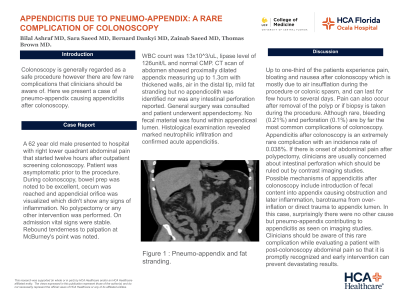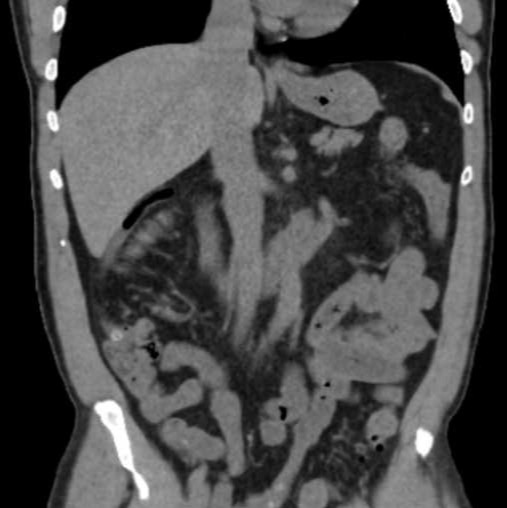Back


Poster Session B - Monday Morning
Category: Colon
B0137 - Appendicitis Due to Pneumo-Appendix: A Rare Complication of Colonoscopy
Monday, October 24, 2022
10:00 AM – 12:00 PM ET
Location: Crown Ballroom

Has Audio

Bilal Ashraf, MD
UCF College of Medicine-HCA GME Consortium/HCA Florida Ocala Hospital
Ocala, FL
Presenting Author(s)
Bilal Ashraf, MD1, Sara Saeed, MD2, Bernard Dankyi, MD1, Zainab Saeed, MD1, Thomas Brown, MD1
1UCF College of Medicine-HCA GME Consortium/HCA Florida Ocala Hospital, Ocala, FL; 2Fatima Jinnah Medical University, Lahore, Punjab, Pakistan
Introduction: Colonoscopy is generally regarded as a safe procedure however there are few rare complications that clinicians should be aware of. Here we present a case of pneumo-appendix causing appendicitis after colonoscopy.
Case Description/Methods: A 62 year old male presented to hospital with right lower quadrant abdominal pain that started twelve hours after outpatient screening colonoscopy. Patient was asymptomatic prior to the procedure. During colonoscopy, bowel prep was noted to be excellent, cecum was reached and appendicial orifice was visualized which didn't show any signs of inflammation. No polypectomy or any other intervention was performed. On admission vital signs were stable. Rebound tenderness to palpation at McBurney's point was noted. WBC count was 13x10^3/uL, lipase level of 126unit/L and normal CMP. CT scan of abdomen showed proximally dilated appendix measuring up to 1.3cm with thickened walls, air in the distal tip, mild fat stranding but no appendicolith was identified nor was any intestinal perforation reported. General surgery was consulted and patient underwent appendectomy. No fecal material was found within appendiceal lumen. Histological examination revealed marked neutrophilic infiltration and confirmed acute appendicitis.
Discussion: Up to one-third of the patients experience pain, bloating and nausea after colonoscopy which is mostly due to air insufflation during the procedure or colonic spasm, and can last for few hours to several days. Pain can also occur after removal of the polyp or if biopsy is taken during the procedure. Although rare, bleeding (0.21%) and perforation (0.1%) are by far the most common complications of colonoscopy.
Appendicitis after colonoscopy is an extremely rare complication with an incidence rate of 0.038%. If there is onset of abdominal pain after polypectomy, clinicians are usually concerned about intestinal perforation which should be ruled out by contrast imaging studies.
Possible mechanisms of appendicitis after colonoscopy include introduction of fecal content into appendix causing obstruction and later inflammation, barotrauma from over-inflation or direct trauma to appendix lumen. In this case, surprisingly there were no other cause but pneumo-appendix contributing to appendicitis as seen on imaging studies. Clinicians should be aware of this rare complication while evaluating a patient with post-colonoscopy abdominal pain so that it is promptly recognized and early intervention can prevent devastating results.

Disclosures:
Bilal Ashraf, MD1, Sara Saeed, MD2, Bernard Dankyi, MD1, Zainab Saeed, MD1, Thomas Brown, MD1. B0137 - Appendicitis Due to Pneumo-Appendix: A Rare Complication of Colonoscopy, ACG 2022 Annual Scientific Meeting Abstracts. Charlotte, NC: American College of Gastroenterology.
1UCF College of Medicine-HCA GME Consortium/HCA Florida Ocala Hospital, Ocala, FL; 2Fatima Jinnah Medical University, Lahore, Punjab, Pakistan
Introduction: Colonoscopy is generally regarded as a safe procedure however there are few rare complications that clinicians should be aware of. Here we present a case of pneumo-appendix causing appendicitis after colonoscopy.
Case Description/Methods: A 62 year old male presented to hospital with right lower quadrant abdominal pain that started twelve hours after outpatient screening colonoscopy. Patient was asymptomatic prior to the procedure. During colonoscopy, bowel prep was noted to be excellent, cecum was reached and appendicial orifice was visualized which didn't show any signs of inflammation. No polypectomy or any other intervention was performed. On admission vital signs were stable. Rebound tenderness to palpation at McBurney's point was noted. WBC count was 13x10^3/uL, lipase level of 126unit/L and normal CMP. CT scan of abdomen showed proximally dilated appendix measuring up to 1.3cm with thickened walls, air in the distal tip, mild fat stranding but no appendicolith was identified nor was any intestinal perforation reported. General surgery was consulted and patient underwent appendectomy. No fecal material was found within appendiceal lumen. Histological examination revealed marked neutrophilic infiltration and confirmed acute appendicitis.
Discussion: Up to one-third of the patients experience pain, bloating and nausea after colonoscopy which is mostly due to air insufflation during the procedure or colonic spasm, and can last for few hours to several days. Pain can also occur after removal of the polyp or if biopsy is taken during the procedure. Although rare, bleeding (0.21%) and perforation (0.1%) are by far the most common complications of colonoscopy.
Appendicitis after colonoscopy is an extremely rare complication with an incidence rate of 0.038%. If there is onset of abdominal pain after polypectomy, clinicians are usually concerned about intestinal perforation which should be ruled out by contrast imaging studies.
Possible mechanisms of appendicitis after colonoscopy include introduction of fecal content into appendix causing obstruction and later inflammation, barotrauma from over-inflation or direct trauma to appendix lumen. In this case, surprisingly there were no other cause but pneumo-appendix contributing to appendicitis as seen on imaging studies. Clinicians should be aware of this rare complication while evaluating a patient with post-colonoscopy abdominal pain so that it is promptly recognized and early intervention can prevent devastating results.

Figure: Pneumo-appendix and fat stranding.
Disclosures:
Bilal Ashraf indicated no relevant financial relationships.
Sara Saeed indicated no relevant financial relationships.
Bernard Dankyi indicated no relevant financial relationships.
Zainab Saeed indicated no relevant financial relationships.
Thomas Brown indicated no relevant financial relationships.
Bilal Ashraf, MD1, Sara Saeed, MD2, Bernard Dankyi, MD1, Zainab Saeed, MD1, Thomas Brown, MD1. B0137 - Appendicitis Due to Pneumo-Appendix: A Rare Complication of Colonoscopy, ACG 2022 Annual Scientific Meeting Abstracts. Charlotte, NC: American College of Gastroenterology.
